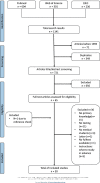The Level of Anatomical Knowledge, Hard to Establish: a Systematic Narrative Review
- PMID: 35528299
- PMCID: PMC9054958
- DOI: 10.1007/s40670-022-01509-w
The Level of Anatomical Knowledge, Hard to Establish: a Systematic Narrative Review
Abstract
Objective: This literature review aimed to gain more insight into the level of anatomical knowledge based on published measurements among medical students, residents, fellows, and specialists.
Methods: We performed an extensive literature search in three online databases: Medline (using PubMed), Web of Science, and Education Resources Information Centre (ERIC).
Results: A total of 30 relevant studies were found. In these studies, participants took different anatomy tests, and their mean/median scaled scores range from 22.5 to 82.4% on a 0 to 100% scale.
Conclusion: This review provides an overview of what is known about measured anatomical knowledge. After critically reviewing the literature, we have to conclude that the existing literature confirms that anatomical knowledge is hard to establish, mainly due to the lack of standardisation.Further research should focus on ways to define and assess 'desired anatomical knowledge' in different contexts. In a next phase, we can discuss if anatomical knowledge is lacking and if interventions are needed.
Keywords: Anatomy; Knowledge; Scientific perspectives; Test.
© The Author(s) 2022.
Conflict of interest statement
Conflict of InterestThe authors declare no competing interests.
Similar articles
-
Beyond the black stump: rapid reviews of health research issues affecting regional, rural and remote Australia.Med J Aust. 2020 Dec;213 Suppl 11:S3-S32.e1. doi: 10.5694/mja2.50881. Med J Aust. 2020. PMID: 33314144
-
Promoting and supporting self-management for adults living in the community with physical chronic illness: A systematic review of the effectiveness and meaningfulness of the patient-practitioner encounter.JBI Libr Syst Rev. 2009;7(13):492-582. doi: 10.11124/01938924-200907130-00001. JBI Libr Syst Rev. 2009. PMID: 27819974
-
Clay-Based Modeling in the Anatomist's Toolkit: A Systematic Review.Anat Sci Educ. 2021 Mar;14(2):252-262. doi: 10.1002/ase.1996. Epub 2020 Jul 23. Anat Sci Educ. 2021. PMID: 32573101
-
Student and educator experiences of maternal-child simulation-based learning: a systematic review of qualitative evidence protocol.JBI Database System Rev Implement Rep. 2015 Jan;13(1):14-26. doi: 10.11124/jbisrir-2015-1694. JBI Database System Rev Implement Rep. 2015. PMID: 26447004
-
The role of augmented reality in Anatomical education: An overview.Ann Anat. 2020 May;229:151463. doi: 10.1016/j.aanat.2020.151463. Epub 2020 Jan 21. Ann Anat. 2020. PMID: 31978568 Review.
Cited by
-
The Influence of Craniometric Variation on the Position of Mandibular Foramen: A Cadaveric Cross-Sectional Study.Medicina (Kaunas). 2024 Nov 23;60(12):1925. doi: 10.3390/medicina60121925. Medicina (Kaunas). 2024. PMID: 39768807 Free PMC article.
-
Assessing anatomical knowledge and confidence in central venous catheter insertion: a single-center cross-sectional study among physicians in a resource-limited setting.Ann Med Surg (Lond). 2025 Mar 18;87(4):1930-1940. doi: 10.1097/MS9.0000000000003169. eCollection 2025 Apr. Ann Med Surg (Lond). 2025. PMID: 40212148 Free PMC article.
-
Enhancing residency training by addressing anatomical knowledge gaps through structured educational programs: a need assessment study in radio diagnosis residents.Surg Radiol Anat. 2024 Dec 17;47(1):36. doi: 10.1007/s00276-024-03541-4. Surg Radiol Anat. 2024. PMID: 39690295
References
Publication types
LinkOut - more resources
Full Text Sources

